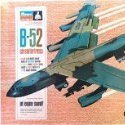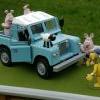

Adam Maas
Members-
Posts
1,024 -
Joined
-
Last visited
Profile Information
-
Gender
Male
-
Location
Toronto, Canada
Recent Profile Visitors
3,478 profile views
Adam Maas's Achievements

Very Obsessed Member (5/9)
522
Reputation
-

I’m having a threesome! Now finished
Adam Maas replied to Farmerboy's topic in Work in Progress - Aircraft
The right sidewall changes a lot between aircraft, depending on what gear is currently fitted (radios, oxygen, et al). If you look at cockpit photos of the real thing, there's a LOT of variation on the right hand side. -
Brunswick Green is a green pigment invented by the Brunswick Brothers in 1795. It is often associated with older US Railroad passenger schemes, especially Heavyweight schemes on the Pennsylvania RR
- 32 replies
-
- 1
-

-
Has Eduard ever gotten the cockpit colour correct on their pre-painted stuff? They've been consistently off for pretty much every set I've seen from them, regardless of subject. I've yet to see it which is one reason I avoid pre-painted stuff from them for anything other than black instrument panels.
-
Two Lightning airframes were used operationally by the RAF, although neither were Lightning 1's. Both were Droop Snoots, although the better documented one was a depot conversion by the RAF. 44-23517 was passed on to Air Commodore Alfred C H Sharp as a hack when he left 8th AF to be base commander at Connigsby. It was converted to a droop snoot configuration after a droop snoot P-38 was loaned to No 5 Group RAF for a month with some success as a master bomber lead. After the modifications, 44-23517 was coded DPA and used in that role until AC Sharp transferred to Northolt.
-
Got distracted with other stuff, but spent some time painting stores and got to glue on the ECM tip pods so I can add the slime light decals
-

Jumping the Shark - The Kinetic J-15 Flying Shark in 1/48
Adam Maas replied to Adam Maas's topic in The Salty Sea Dog GB
That's probably what I'll end up doing. Locating two of the bits is the bigger issue, because of their prominent location on the inner wings. Photo references FTW there. -

Jumping the Shark - The Kinetic J-15 Flying Shark in 1/48
Adam Maas replied to Adam Maas's topic in The Salty Sea Dog GB
been puttering away here and there. Running into two bits that annoy me, the locations for some bits are not positive at all (cockpit sidewalls) and while there are diagrams for the holes you need to cut to add some J-15 specific bits, there's no locates in the plastic, no measurements in the diagram (apart from hole size) and most of the holes are square, not round. Got the sidewalls in with an assist from the cockpit tub for locating them. And then started on the outer wings while I waited for glue to dry -

Jumping the Shark - The Kinetic J-15 Flying Shark in 1/48
Adam Maas replied to Adam Maas's topic in The Salty Sea Dog GB
Working on the lower fuselage Gear bays come like this: Then you install walls and pipes to get this: Pretty slick overall and the fit is good. I also got started on prepping the intakes for paint. -

HMS Hermes (1919); Aoshima 1/700; RN's first propah carriarr
Adam Maas replied to Ngantek's topic in The Salty Sea Dog GB
Hermes and Hosho were the first two carriers laid down explicitly as carriers. Argus was a conversion like Langley. Furious was actually the first to complete construction as a carrier and Eagle was the first true capital ship conversion (it's really hard to call any of the Courageous class hulls capital ships) Hosho was never intended as an oiler, it was ordered as the lead of a 2-ship Seaplane Carrier class in 1918 under the 8-6 program (the other being intended to be named Shokaku, which was cancelled in 1922 after languishing in design hell for several years and was never laid down, the name getting recycled some years later), The design was originally inspired by HMS Campania but was changed to a two-deck carrier like HMS Furious after its first refit in mid-1918 then to a flush deck carrier like HMS Argus in April 1919 after reports on the issues with HMS Furious's deck setup were received from the RN. This is what was laid down and built. Hiryu is not a name the IJN would have assigned to an oiler in 1919 anyways. The class of oilers under construction at the time were all named for capes (the Notoro class) and all of them were completed as planned. The next class was the Kamoi class which was first laid down in 1921. There is a connection to Hosho however, as several of these oilers including both Notoro and Kamoi would be converted to seaplane tenders, taking the role that Hosho and Shokaku were originally authorized for.- 83 replies
-
- 3
-

-

-

HMS Hermes (1919); Aoshima 1/700; RN's first propah carriarr
Adam Maas replied to Ngantek's topic in The Salty Sea Dog GB
Interesting choice of subject. As a note, Hermes was the first carrier laid down as such, but Hosho would actually be the first true carrier to commission, with a rather much shorter build time- 83 replies
-
- 4
-

-

-

Jumping the Shark - The Kinetic J-15 Flying Shark in 1/48
Adam Maas replied to Adam Maas's topic in The Salty Sea Dog GB
So this will be the third Kinetic kit I've started, the previous two still languish on the shelf of doom. This is also the newest and best designed, but it's not one of their Gold kits (the previous two are the 1/72 F-16D Block 52+ and the first release of the F-5A with CF-5A markings) I started with the cockpit. It's very nicely detailed for a plastic pit, but the rear wall could have been better engineered. Just a butt joint with a small lip, no really positive interlock or location like a ZM or Tamiya kit would have. Note I'm aware this is an Su-33 pit and the real J-15 is different. Then the nose gear bay. Some nice detail and nicely laid out engineering, but the end caps are butt joints again with minimal location. Fit is rather good and unlike the rear cockpit wall, there's a lot of gluing area for the end caps. -
I'm generally not one to do Soviet designs of any sort, nor do I normally build grey jets in operational schemes. Looking through the stash left me with 3 subjects tickling my fancy for this GB, the F-14 (I have the AMK D and Tamiya early A kits), the F-4 (Academy J and Tamiya B for seagoing examples) and the Kinetic J-15 Flying Shark (Chinese Su-33) which I bought on a whim while on sale at the LHS for Boxing Week. I have plans for both F-14's for later and I'm already building an F-4 right now (ZM F-4G), so the J-15 it is. I do dig the tail art on this one, which is a big part of why I bought a boring grey jet.
-
I'm in on this one, and I'm going to Jump the Shark. Namely I'm going to do a Flying Shark that uses Ski Jumps. The Kinetic J-15 will be my subject here.
-
Brewster Corsairs certainly flew off carriers a fair bit. That was part of the training regimen they were used for. JS716 for example was written off when the pilot ignored a cut signal and attempted a go around despite having the hook engaged. That was on USS Charger in Chesapeake bay. The question for that picture is was the shot taken while working up off the US, or operationally somewhere else. October 1944 suggests an operational airframe as Victorious was out east already and flying operationally and the frames are stills from 16mm film that's well sourced and the uniforms worn match the location. This most likely is a simple case of a specific airframe getting allocated against policy because the ship was leaving and it is what was available.
-

New tool Canadian CT-114 Tutor in 1/48 scale from Kinetic Model
Adam Maas replied to Julien's topic in The Rumourmonger
Offhand, my guess is a Canadian Forces boxing at release (I agree with the Big 2, a Snowbirds scheme that's good for a couple years and a special scheme option in the first boxing). Then probably a Snowbirds dedicated boxing (not all, but the highlights), a Special Scheme boxing and a RMAF boxing (the latter maybe in concert with somebody else)






